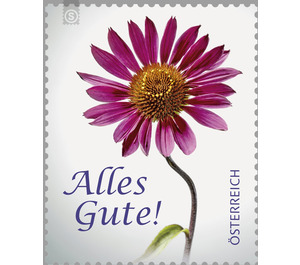congratulations - Austria / II. Republic of Austria 2013 - 62 Euro Cent
Theme: Science
| Country | Austria / II. Republic of Austria |
| Issue Date | 2013 |
| Face Value | 62.00 |
| Printing Type | offset |
| Stamp Type | Definitive |
| Item Type | Stamp |
| Chronological Issue Number | 2386 |
| Chronological Chapter | OOS-OE2 |
| SID | 58033 |
| In 64 Wishlists | |
Literally through the flower, one can speak with the new congratulatory brand, as it shows a purple "sun hat" blossom and bears the inscription "Alles Gute!". The charming permanent stamp without denomination imprint is valid as a franking for Austrian standard domestic shipments, currently € 0.62, and is available at all points of sale of Austrian Post AG. Sunhats are a genus of plants from the family of the so-called daisy family, the botanical genus name "Echinacea" is derived from the ancient Greek word echinus for sea urchins and refers to the genus typical, the tubular flowers towering, spiky spike leaves. The sun hat is known as an ancient medicinal plant, already the Indians of North America allegedly used the sun hat for cough, sore throat and tonsillitis. Today, the plant's active ingredient is used to help with respiratory or urinary tract infections as well as externally on poorly healing wounds. In particular, the species Echinacea purpurea, pallida and angustifolia are used. A few years ago, scientists from the University of Connecticut (USA) were able to demonstrate a reduction in the risk of infection by 60 percent and accelerated healing by echinacea preparations for an average of one and a half days. Depending on the species, the perennial herbaceous and differently hairy plants can reach a stature height of an incredible 140 centimeters; the alternate, basal and distributed on the stems arranged leaves are more or less long-stalked. The simple leaf blade (= flat part of the leaf that sits above the stem) has one, three or five leaf nerves. The leaf margin, however, is usually smooth, but can also - depending on the type - be serrated or sawn. The flower-shaped inflorescences are individually terminal on relatively long stems, the circular flower basins have diameters of about 1 to 4 centimeters, and the inflorescence bottoms are spherical to cylindrical. The flower baskets contain eight to 21 florets and 200 to 300 tubular flowers. The asexual ray florets are yellow, white, dark purple to light pink, while the hermaphrodite, fertile tubular flowers are pink to reddish purple, greenish or yellow with five corolla lobes; the pollen is mostly yellow.


